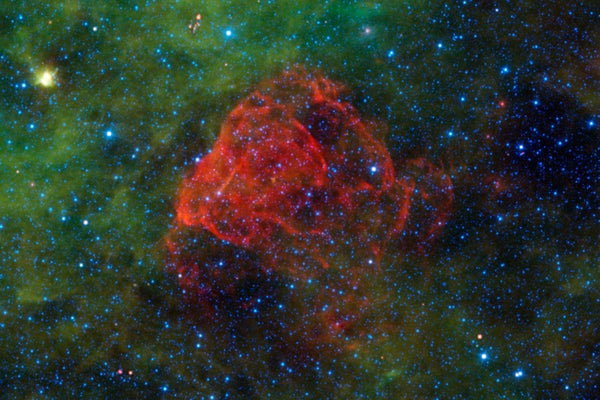The explosions that blew apart the universe’s first stars are shrouded in mystery. These energetic blasts are inherently difficult to recreate in computer simulations, even using modern computing power. “It’s one of the hardest physics problems out there,” says Alexander Ji, an astrophysicist at the Carnegie Observatories in Pasadena, Calif. Furthermore, he notes that researchers still lack an answer to a simple question: What types of stars do—and do not—explode?
Scientists often assume the first stars ended their lives as spherical supernovae. A team of researchers, however, just presented the first observational evidence that at least one of these ephemeral fireballs instead exploded aspherically, spewing its contents out unevenly in multiple directions. The explosion flung forth jets powerful enough to propel heavy elements forged in the blast into neighboring galaxies, the researchers note in a study published on May 8 in the Astrophysical Journal. (Ji was not involved in the study, but his former doctoral advisor is one of its authors.)
The paper is part of a major push to study the properties of the first stars, which has been a hot topic for the past decade, says Volker Bromm, an astronomer at the University of Texas at Austin, who also was not involved in the study. The idea that jets spew out of exploding stars, slinging heavy elements into neighboring galaxies and seeding the next generation of stars is not new. Researchers have even previously theorized the occurrence of this phenomenon in the first generation of stars. Still, this study is the first to find observational evidence of it in one of these early stars.
On supporting science journalism
If you're enjoying this article, consider supporting our award-winning journalism by subscribing. By purchasing a subscription you are helping to ensure the future of impactful stories about the discoveries and ideas shaping our world today.
A Special Star
Because the first stars—short-lived giants that all died long ago—are not available to study directly, Rana Ezzeddine, an astronomer at the M.I.T. Kavli Institute for Astrophysics and Space Research and the lead author on the study, and her colleagues studied the abundances of iron and other elements found in a second-generation star called HE 1327-2326. It belongs to a rare group of about 25 to 30 ancient stars that contain very low amounts of iron. These stars arose out of elemental seeds left behind by progenitor stars from the first generation.
“Our star is very special, because it is also the brightest one” of that group, Ezzeddine says. Still, measuring its elemental abundances required the use of the Cosmic Origins Spectrograph aboard the Hubble Space Telescope—one of the most sensitive instruments available. “This is a beautiful paper,” Bromm says, noting that this type of stellar sleuthing is possible only with very high-quality data.
The team expected to find the presence of silicon, iron and phosphorous in the spectrum, but their discovery of a different element was a shocker. For the first time, they found zinc in a second-generation star, Ezzeddine says—and not just a little, but a lot. Stunned by this finding, which could signal that more heavy elements were available in the early universe than previously thought, the researchers repeated their analysis. With every check, their zinc finding persisted.
Elemental Surprise
This finding turned the project on its head. Researchers already knew why this star and others in its group do not contain much iron. Iron was formed in the cores of the massive first stars that were the progenitors of the metal-poor ones, Ezzeddine says. When these first stars collapsed in on themselves, much of the iron from their cores fell back into the resulting black holes, she notes. Zinc is also formed in the cores of these ancients, however, leading the team to wonder how the element escaped this black hole fate.
This oddity can be explained by an aspherical explosion of the supernova, Ezzeddine says. The resulting jets could fling the core’s zinc away from a black hole while also allowing most of its iron to fall back into one. To explore this theory, the researchers ran over 10,000 computer simulations of exploding supernovae with different explosion energies and configurations. Remarkably, they discovered that none of the spherical supernovae explosions could produce the observed zinc signal. Furthermore, they found just one aspherical supernova explosion that could yield the observed zinc signal and other characteristics of HE 1327-2326.
This led them to another surprise: how powerful the asymmetrical supernova explosion could have been. Its explosiveness likely had about a nonillion times (10 with 30 zeroes after it) the power of a hydrogen bomb, the researchers estimate—that is about five to 10 times more energetic than previously thought. The study provides new evidence that the explosions of the universe’s first stars may have contributed to the universe’s reionization—an important milestone in the early cosmos when neutral atoms became charged—and played a critical role in the development of galaxies.
John Wise, a computational astrophysicist at the Georgia Institute of Technology who is currently studying how metals propagated from the first generation of stars to the second, says this study has already inspired him to modify his methodology for that project. “Now we have some motivation to look at aspherical supernovae,” he says. Researchers do not yet know whether the likely aspherical explosion of the supernova preceding HE 1327-2326 was a rarity or a common occurrence. They still wonder whether the bulk of supernova explosions from the first generation were spherical or aspherical. So, though it appears they have approached a solution to one mystery about the first stars, numerous others abound.
